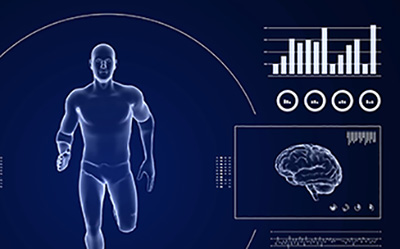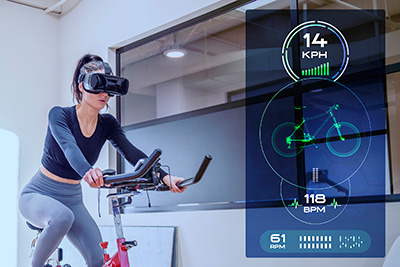At BML Technology we’re evangelists for digital health and medical technology solutions because we understand their potential and the results that are already being achieved. We’ve written at length about how the healthcare field is experiencing a once in a lifetime revolution due to the emergence of digital health technology and what it makes possible.
We have seen how emerging medical technology is allowing a wide array of unmet clinical needs to be addressed in new ways. An interesting development taking place is that the supporting technologies making this possible – Bio sensors, miniaturization, artificial intelligence, machine learning, optical measurement, predictive modeling, wireless communications, GPS and others – are also actively revolutionizing other fields.
In this article we will look at how these technologies born in the digital health and medical devices field are impacting the sports world, athlete health and the way sports are being played, particularly through the usage of sports wearables and trackers.
Key drivers in the adoption of medical device technology in the sports world

Key drivers for the adoption of digital technology in sports are the sheer market size and the economic incentives in professional sports. Professional sports are a multi billion dollar industry; teams are worth millions to billions, contract sizes given to the best players can easily exceed $30 to $40 million per year for popular sports in major markets, and even mid level players in secondary markets earn what can only be described as significant sums.
The money at stake for winning teams and the investment in players, coaches, and infrastructure have created an environment where teams are looking for any edge that will help them not only to win but also to keep their players healthy and on the field. Player injury is extremely costly to teams in direct financial terms as salaries paid to injured players and by reducing the chances of winning. It has become a common occurrence in major sports that the team that wins the championship, or the player in individual sports, is the one that manages to stay healthy throughout the season, the playoffs and at championship time.
These incentives also permeate the competitive world of amateur sports, where many of the athletes involved aspire to reach the professional ranks and where there are significant financial and prestige benefits for successful countries, schools and programs. Adopting digital technology in the form of sports wearables and other tools is a natural evolution in the quest for peak performance by athletes and teams.
Five of the major ways digital technology is being used by sports teams and athletes today include:
1. Fitness and Conditioning:

Sports wearables are an ideal tool to track and improve an athlete’s overall fitness and conditioning levels. Sports wearables and smart clothing measuring workout time, heart rate (HR), heart rate variability (HRV) and recovery times, blood pressure (BP), blood oxygen levels, speed, distance covered and other metrics can all be tracked and measured to come up with a data driven fitness and conditioning plan that challenges the athlete to increase their conditioning level intelligently over time based on their own personal capability and results.
2. Load Management:
The ability to know accurately how much work output an athlete has performed over a period of time is another advantage of sports wearables and other digital tracking and measurement tools. Injuries often occur when athletes are functioning at the outer edges of their physical capacity, this is due generally to excessive work output. Utilizing sports wearables, smart clothing and other sensors allows the coaching staff to know exactly how much work an athlete has undertaken and at what proportion of their maximum capability. Time, steps taken, distance covered, speed, HR, HRV, BP, blood oxygen, breathing rate and other metrics can all be used to manage an athlete’s load and provide them with rest and hydration as necessary.
3. Rest and Recovery:
The quantity and quality of an athlete’s rest and recovery cycles are critically important to their ability to subsequently perform again at the highest levels on short turnaround periods, often as short as one day. The length and quality of sleep along with any disturbances, as in the form of sleep apnea, can be measured with sleep monitors and trackers which are now available in contactless form to avoid disturbing the athlete. An athlete’s level of nutrition and hydration are also critical, and can be tracked and measured over time. HRV is another key metric that can be tracked and measured over time, the variance between an athlete’s heart metrics at rest versus when performing are a key indicator of overall fitness.
4. Injury Prevention:

Understanding an athlete’s overall fitness and conditioning level, work output, bio-mechanical feedback and rest and recovery processes can be helpful towards identifying the possibility that an athlete is reaching a level where injury may occur. With the help of sports wearables and other tracking and assessment tools the coaching staff can get the information necessary to ascertain whether the athlete is conditioned enough and is getting the necessary rest and recovery to handle the workloads they are putting in. Artificial Intelligence and machine learning algorithms also assist in identifying problem areas.
5. Strategy Development and Execution:
At the team level there are myriad ways to utilize digital technology to improve performance, this also applies to individual sports. We’re all familiar with the widespread use of Data and Analytics in sports glamorized in the movie “Moneyball”, in which the heroic General Manager of the Oakland A’s is able to field an extremely competitive team at a fraction of the payroll of the leading large market teams by focusing on data and analytics. Tracking the data sets and understanding the analytics allows teams to develop winning strategies that would not have been identified without the data tools. Combining analytics data with the athlete’s wearable data makes for a powerful combination and unlocks a whole new set of strategic opportunities for team management.
Types of Products
- Pedometers and Step Trackers
- Heart Rate and Heart Rate Variability Monitors
- Fitness monitors
- Smart Fabrics
- Smart Cameras
- Shot Trackers
Sites on the Body
- Arm and Wrist
- Headbands
- Handhelds
- Shoe Sensors
- Uniform Clips
Sports Applications
- Step Counters
- Distance Covered Trackers
- Calories Burned
- Heart Rate Monitoring
- Heart Rate Variability Monitoring
- Sleep Trackers
Wearable Device End Users
- Sports Teams and Associations
- Individual Athletes
- National Sports Organizations
- Sports Centres
- Fitness Centres
- Homecare Settings
In addition to the uses outlined in this article in the fields of sports, sports medicine and athletic performance we are also seeing these technologies deployed in other fields where the tracking, measurement and management of human biometrics can be helpful. These fields include numerous work settings, manufacturing, transportation, emergency response, law enforcement, military and many others.
We expect that with the continued expansion in the capabilities and scope of wearable devices and the ongoing evolution of smartphones, handhelds and trackers towards becoming full-on consumer wearable medical devices this trend will only grow.
About BML Technology
BML Technology understands digital health. At the intersection of medical technology, clinical research and patient-centric healthcare BML drives the mainstream adoption of digital technology in healthcare. Offering a full range of services to the digital health ecosystem BML manages the complex stakeholder interactions necessary to get digital health solutions to market and gain adoption.
Stay Connected with BML Technology.
Connect with BML Technology on LinkedIn.

